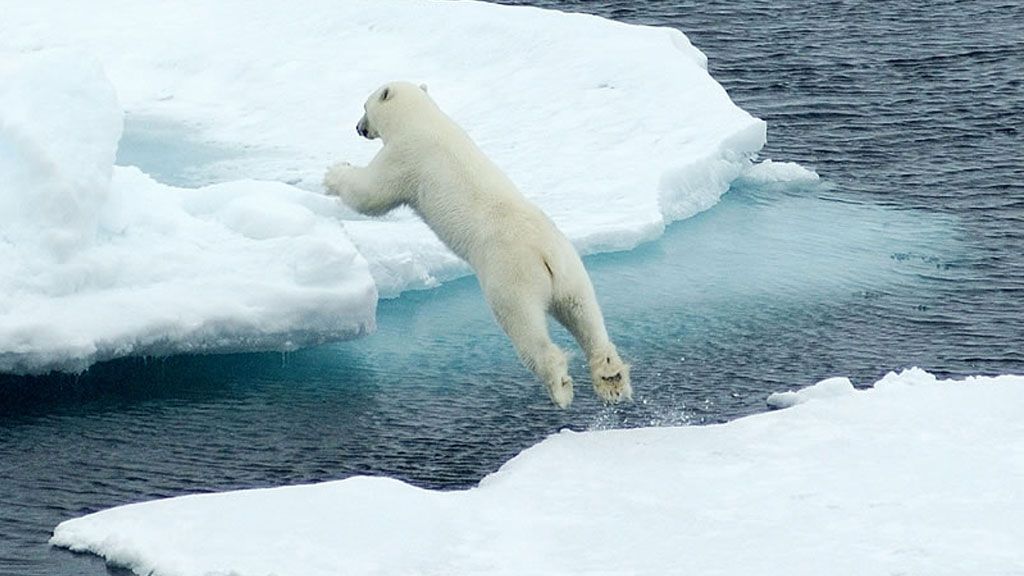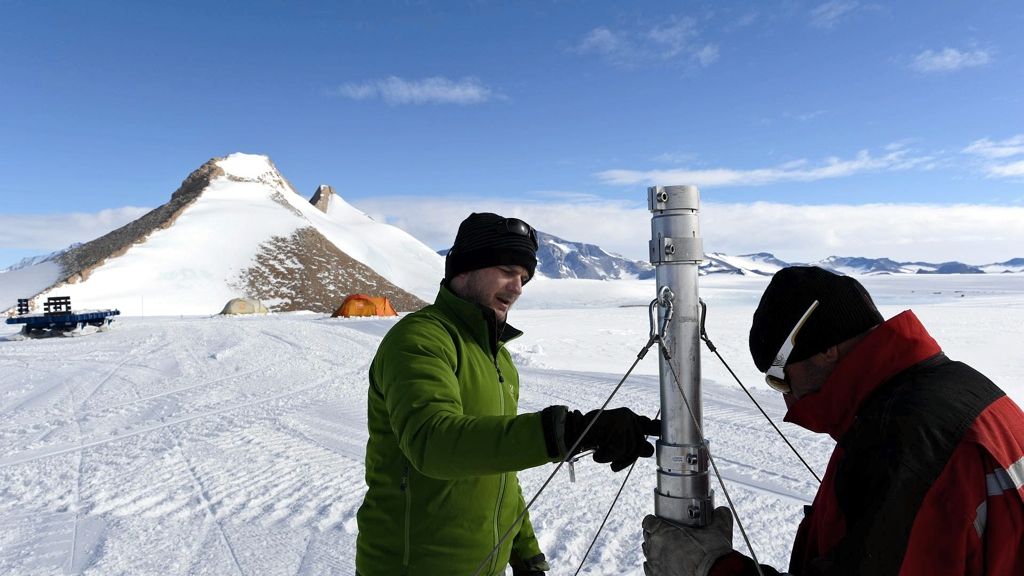Arctic sea ice extent, its history and how It affects the carbon cycle
Polar bear making its way across the Arctic sea ice floe
© MARTIN JAKOBSSON
Professor Martin Jakobsson from Stockholm University has been involved with several research expeditions using geophysical mapping methods to study the morphology of the Arctic Ocean's seafloor in order to learn more about the Arctic's oceanographic and environmental history. The research he is invovled with is contributing to a better understanding of how sea ice cover in the Arctic has changed over the past several million years.
In this interview, Prof. Jakobsson details what we know about past sea ice cover in the Arctic and the interlinkages between sea ice and the carbon cycle.
What exactly is known right now about past sea ice cover in the Arctic?
The first indication of there being any kind of seasonal ice cover in the Arctic is about 47.5 million years ago. It is believed that this was some sea ice around the rim of the Arctic. This record is built on the one and only long sediment core taken from the Lominosov Ridge in the centre of the Arctic Ocean in 2004 during the Arctic Coring Expedition (ACEX). That core has been studied by many different people. The conclusion that 47.5 million years ago we saw the first signs of sea ice is not just the conclusion This is the conclusion Catherine Stickely from the University of Tromsø and the Norwegian Polar Institute reached along with her colleagues in their research published in Nature in 2009.
Around 47 million years ago, there seems to have been a greater extension of sea ice; more offshore sea ice began to form. This was concluded because remains of ice-dependent diatom species appear in sediment from the core from about 47 million years ago. However while there’s no indication that there was perennial sea ice cover in the Arctic like we have today. Sea ice cover was probably more like what we see in the Baltic Sea today – maybe even less: ice grows at higher latitudes in the winter, but it all disappears in the summer.
On what kind of scale is it possible to resolve Lominosov Ridge sediment core data?
The whole record has been spliced together from the 428-metre core extracted from the Lominosov Ridge. When you're looking at records that go this far back, the resolution is not all that great. It’s a very tedious process reading them. So researches have been zooming in on some areas of the sediment core to do some sparse sampling (meaning there could be more than a hundred thousand years in between each sample) to try and see what was happening with the sea ice at different times.
A study by Dennis Darby from Old Dominion University and other colleagues indicate that there has been a ramping up of more coarse-grained material between 13 and 14 million years ago, which is a sign that this was perhaps the first time there was any perennial sea ice cover in the Arctic, at least in the Earth’s recent geological history.
Again, this is based on very sparse sampling, so there could have very well been periods in between when sea ice cover wasn’t perennial and only seasonal. We saw this happen much more recently in the Earth’s geological history during the Holocene Climactic Optimum some 5,000 – 9,000 years ago. With these long sediment cores, you do your best in trying to reconstruct geological history, but nevertheless, you’re only going to be able to sample at sparse time intervals, because it’s a very long record and you have to do very tedious analyses.
On the other hand, when you get to the Quaternary Period (which began about 2.5 million years ago), then we have records at a much higher resolution, and then you can distinguish what was going on much more clearly. During the Holocene Climactic Optimum, there are several studies that indicate the Arctic might have had no or very little sea ice in summer. I published a paper with colleagues last year on this topic in Quaternary Science Reviews, summarizing all these recent records. Since then, other studies have further reinforced the idea of little or no summer sea ice cover during this period.
However the ice-free summers in the Arctic during the Holocene Climatic Maximum coincided with a period of much higher summer solar insolation for the Northern Hemisphere. Today, sea ice is diminishing but we don’t have higher summer solar insolation in the Northern Hemisphere. This supports the idea that increased concentrations of greenhouse gasses in the atmosphere are responsible for warming, which brings consequences for sea ice today.
But it’s tricky to separate all these things. There were a lot of feedback mechanisms that were going on between different systems during the Holocene Climactic Optimum. But it definitely was a lot warmer, and human activities weren’t responsible for the warm period in the early Holocene.
In an earlier interview, David Barber from the University of Manitoba mentioned that the last time we had an ice-free Arctic might have been a million years ago. Could you shed some light on this hypothesis?
It depends on what you mean by ice-free. Only ice-free during the summer or without ice entirely? Even though during the Holocene Climatic Optimum there was little or no summer sea ice cover, there was certainly still a lot of ice in the Arctic. You still had glaciers and ice sheets and the like. We’re currently heading out of an ice age, so the glaciers were probably a lot larger and extended much further out back then.
We have to be frank. Those of us who work with paleoclimate records have a lot more to learn about Arctic climate history. We need to have higher resolution records going further back in time. We really don’t have that many good sediment records from the Arctic yet that have been studied in detail to determine the sea ice history. This is coming. This is one of the main goals of the next expedition we’re planning SWERUS-C3.
What do we currently know about how the carbon cycle and sea ice are interlinked?
I can tell you what we don’t really understand at this point. That’s perhaps a better way of approaching the question.
We are trying to figure out the feedback mechanisms at play. You can definitely see that there is a link between sea ice and the carbon cycle. If you remove the sea ice, you will change a lot of the boundary conditions in the Arctic Ocean. One of the big unknowns is how the circulation of water masses in the Arctic will be affected if the sea ice is completely removed. There have been numerical modelling experiments to see what might happen. But what we’re doing in our work is trying to go into the past – particularly during the early Holocene – to see if we can get any hints as to what might happen from past events as sea ice diminishes. We want to be able to see what the different conditions were in the Arctic when the sea ice wasn’t there.
One thing that immediately comes to mind and which has a direct impact is Arctic coastal erosion – which happens along all Arctic shorelines, but is specifically pronounced along the Siberian Coast. Right now we’re seeing a scary rate of coastal erosion. This has been going on since the last deglaciation, when the retreat of the sea ice started to expose the continental shelf.
Of course water will come up and erode the coast when sea ice is no longer covering it. The difference is if there’s sea ice cover, you don’t get the same kind of wave action. Sea ice dampens the wave action. But once you remove the sea ice, you start to build pretty big waves, and the waves will hit the shore and erode the shore pretty rapidly, at a completely different rate. When this happens, you release the carbon stored in the Yedoma permafrost sediments (Pleistocene-age permafrost rich in carbon and composed primarily of ice and sediment) along the coast of Siberia. There’s a lot of old carbon stored there, and when this erodes, you release this back into the system.
Another thing is the relic permafrost, which has been around since the last glaciation. I’m talking in particular about the Siberian Shelf – which is a huge, shallow continental shelf. As far as we know, this area wasn’t glaciated during the last glacial period. It was a dry area that was exposed, and so you had a chance to build up a lot of permafrost there. We see that some holes are starting to form in this area of permafrost now. And then what happens is you start to leak carbon into the water column, and from there a lot of this carbon released into the water column is transformed into carbon dioxide and methane. There have been recent studies showing that there are very elevated levels of methane in the water along the Siberian Continental Shelf.
So that’s what’s been going on recently. What I and my colleagues in the paleoclimatology community have been doing is to look at the sea ice history and the carbon cycle history. The Arctic Ocean sediment record is, I would say, like a big, grand old library. You archive whatever happened in the sediments. What we’ll be doing in the SWERUS-C3 project is hunting for very good sediment archives at a higher resolution than before. We’ll go into more detail using all sorts of approaches to analyze them using chemical and biological methods. We’ll also examine microfossils. We hope to learn a lot more from this project.

Martin Jakobsson
Professor Martin Jakobsson is a professor at Stockholm University who has conducted extensive research on Arctic paleoclimates, with a focus on the oceanographic and environmental history of the planet’s polar oceans and their sea ice cover.





